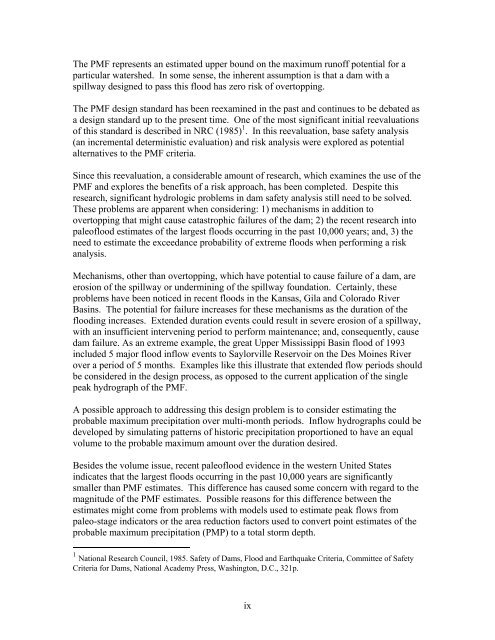Hydrologic Issues for Dams - Association of State Dam Safety Officials
Hydrologic Issues for Dams - Association of State Dam Safety Officials
Hydrologic Issues for Dams - Association of State Dam Safety Officials
Create successful ePaper yourself
Turn your PDF publications into a flip-book with our unique Google optimized e-Paper software.
The PMF represents an estimated upper bound on the maximum run<strong>of</strong>f potential <strong>for</strong> aparticular watershed. In some sense, the inherent assumption is that a dam with aspillway designed to pass this flood has zero risk <strong>of</strong> overtopping.The PMF design standard has been reexamined in the past and continues to be debated asa design standard up to the present time. One <strong>of</strong> the most significant initial reevaluations1<strong>of</strong> this standard is described in NRC (1985) . In this reevaluation, base safety analysis(an incremental deterministic evaluation) and risk analysis were explored as potentialalternatives to the PMF criteria.Since this reevaluation, a considerable amount <strong>of</strong> research, which examines the use <strong>of</strong> thePMF and explores the benefits <strong>of</strong> a risk approach, has been completed. Despite thisresearch, significant hydrologic problems in dam safety analysis still need to be solved.These problems are apparent when considering: 1) mechanisms in addition toovertopping that might cause catastrophic failures <strong>of</strong> the dam; 2) the recent research intopale<strong>of</strong>lood estimates <strong>of</strong> the largest floods occurring in the past 10,000 years; and, 3) theneed to estimate the exceedance probability <strong>of</strong> extreme floods when per<strong>for</strong>ming a riskanalysis.Mechanisms, other than overtopping, which have potential to cause failure <strong>of</strong> a dam, areerosion <strong>of</strong> the spillway or undermining <strong>of</strong> the spillway foundation. Certainly, theseproblems have been noticed in recent floods in the Kansas, Gila and Colorado RiverBasins. The potential <strong>for</strong> failure increases <strong>for</strong> these mechanisms as the duration <strong>of</strong> theflooding increases. Extended duration events could result in severe erosion <strong>of</strong> a spillway,with an insufficient intervening period to per<strong>for</strong>m maintenance; and, consequently, causedam failure. As an extreme example, the great Upper Mississippi Basin flood <strong>of</strong> 1993included 5 major flood inflow events to Saylorville Reservoir on the Des Moines Riverover a period <strong>of</strong> 5 months. Examples like this illustrate that extended flow periods shouldbe considered in the design process, as opposed to the current application <strong>of</strong> the singlepeak hydrograph <strong>of</strong> the PMF.A possible approach to addressing this design problem is to consider estimating theprobable maximum precipitation over multi-month periods. Inflow hydrographs could bedeveloped by simulating patterns <strong>of</strong> historic precipitation proportioned to have an equalvolume to the probable maximum amount over the duration desired.Besides the volume issue, recent pale<strong>of</strong>lood evidence in the western United <strong>State</strong>sindicates that the largest floods occurring in the past 10,000 years are significantlysmaller than PMF estimates. This difference has caused some concern with regard to themagnitude <strong>of</strong> the PMF estimates. Possible reasons <strong>for</strong> this difference between theestimates might come from problems with models used to estimate peak flows frompaleo-stage indicators or the area reduction factors used to convert point estimates <strong>of</strong> theprobable maximum precipitation (PMP) to a total storm depth.1 National Research Council, 1985. <strong>Safety</strong> <strong>of</strong> <strong><strong>Dam</strong>s</strong>, Flood and Earthquake Criteria, Committee <strong>of</strong> <strong>Safety</strong>Criteria <strong>for</strong> <strong><strong>Dam</strong>s</strong>, National Academy Press, Washington, D.C., 321p.ix

















